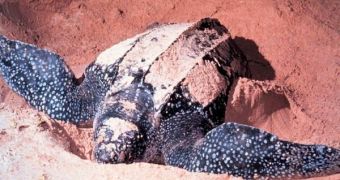Scientists announced yesterday that they had just discovered the largest population of the critically endangered leatherback turtles, on the beaches of Gabon, in West Africa. Anywhere between 15,730 and 41,373 females inhabit the beaches of the area, land and airborne surveys of the region have shown, which means that this is the largest congregation of these animals ever witnessed.
This type of turtles is highly endangered, and the International Union for Conservation of Nature (IUCN) has placed it on the highly endangered list. While populations in the Asia-Pacific region have plummeted by more than 90 percent in the decade between the 1980s and the 1990s, detailed estimates for the Atlantic region, and especially for Africa, are missing, LiveScience reports.
In charge of the new research were experts from the Wildlife Conservation Society (WCS), working together with scientists from the University of Exeter, in the UK. The two institutions are the leaders of the Gabon Sea Turtle Partnership (GSTP) initiative, which is, in fact, an association made up of several international or national organizations in Gabon that are concerned about the safety of marine animals off the country's coasts.
“These findings show the critical importance of protected areas to maintain populations of sea turtles. Gabon should be commended for creating a network of National Parks in 2002 that have provided a sanctuary for this endangered species as well as other rare wildlife,” Wildlife Conservation Society representative Angela Formia said. She is also a co-author of a new paper detailing the find, published in the May issue of the scientific journal Biological Conservation.
“We knew that Gabon was an important nesting site for leatherback turtles, but until now had little idea of the size of the population or its global ranking. We are now focusing our efforts on working with local agencies to coordinate conservation efforts to ensure this population is protected against the threats from illegal fisheries, nest poaching, pollution and habitat disturbance, and climate change,” University of Exeter expert Matthew Witt, who has also been the lead author of the new paper, added.
During their surveys of the coasts, the researchers were able to estimate the number of turtles nesting in the sands, but also to identify the most critical areas for the leatherback turtles. This information may prove to be invaluable when experts will have to devise conservation programs that can reach as many of the animals as possible. One of the saddest conclusions of the study, the experts shared, was the fact that they had learned that about 80 percent of all leatherback turtles in the world only nested in protected areas and national parks, which meant that their global population was still in decline.
A number of research institutes and official agencies supplied funds for the Biological Conservation paper, including the Natural Environment Research Council, the United States Fish and Wildlife Service, and the Marine Turtle Conservation Fund, of the US Department of the Interior.

 14 DAY TRIAL //
14 DAY TRIAL //